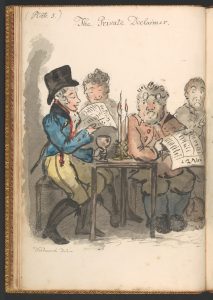In addition to student reflections on their reading practices (see here for our first one), academic members of the Active Online Reading project are sharing insights into various aspects of their own reading pedagogies and practices. Dr Jon Chandler (UCL) is the first to offer his thoughts – on the reading of primary sources.
It was while studying for my PhD in History that I first began to read online texts extensively. During my undergraduate degree most of my reading had been made available the old-fashioned way: as photocopies circulated to the class the previous week! Accessible e-books were still some time away. However, archives had begun to digitise their collections and I soon discovered that there were vast collections of primary sources that I could now access without having to travel long distances. This massively expanded the potential scope of my research and I made extensive use of digitised collections for my PhD which ultimately became my first book.

Reading digitised primary sources was – and still is – quite a different proposition to reading e-books and journal articles. In the old days many of these digitised sources were not searchable: they were simply scans that were uploaded as image files. Reading these collections could be laborious: eyes straining at blurry images and an execrable wait while they loaded. Downloading images was slow and impractical: the downloads would often be so large or poor quality that they were impossible to work with. Instead, I made notes in a notepad or a word document. My reading practice, then, was largely the same as if I was working with a physical text in front of me.
Advances in optical character recognition (OCR) technology means that more and more primary sources are now fully searchable. Printed sources, such as historical newspapers, are particularly responsive to this technology. And, let’s face it, who really wants to sit and read through hundreds of newspapers in a vain search for an obscure reference? Keyword searching has transformed the research practice of a generation of historians. Researchers like me can now put a few keywords into a database and effortlessly obtain thousands of results in seconds. Without this technology this process would have taken months, or even years.

However, the problem with keyword searching is that it gives an illusion of significance where they might well be none. Take my postgraduate research: I was interested in finding out how settlers in Colonial America imagined their place in the world during the American Revolution. What words did they use to describe their new nation? Keyword searches of newspaper databases reveal thousands of hits for terms like ‘United States,’ ‘America,’ or ‘Columbia’ across dozens of newspapers scattered across the thirteen colonies. It was easy to locate these sources, but it was much more difficult to ascribe meaning: at what point do passing references in newspapers add up to a more significant change in the expression of national identity? Of course, to find out, I had to discover more about these passing references: I needed to click through to the article that contained the highlighted keyword and read around it to gain a sense of its context. I soon discovered that for every useful find, there were many others where either the keyword had been misidentified or where it was used in a different context.
As I was working my way through thousands of search results when I had an unsettling epiphany: my focus on keywords had transformed my reading practice. I was no longer reading the primary sources as a whole or making useful notes. Instead, I was zeroing-in on keywords, reading around the article, and downloading relevant articles to a folder that (I told myself!) I would return to later. Furthermore, my reading practice was completely divorced from how these newspapers were intended to be consumed. The editors who first published the newspapers back in the eighteenth century had designed them to be read from front to back, beginning with the headlines, then foreign and domestic news, and rounding off with a barrage of adverts in the back pages. The original readers might not have read the newspaper front to back in one sitting but, in a world where reading a newspaper was a mark of relative privilege, it would have been thoroughly consumed, digested, and passed around among friends and relatives. Yet here I was, cherry-picking keywords and short articles that spoke to my own research. Could I truly understand the world that my historical subjects experienced if my reading practice was so utterly divorced from theirs?
I’m not sure of the solution to my keyword conundrum. Keyword searching is not going anywhere, and it remains a powerful tool for historians to navigate increasingly vast collections of primary sources. And historians will always read sources differently to people in the past: we will have a greater knowledge of context, and consequence, and we use this to draw new and different conclusions. But if the purpose of a historian, as someone once said, is to step into someone’s shoes and go for a walk in them, we must also think about what we lose when we alter our reading practice. As for me, I haven’t stopped using keywords. But I do try to slow down and read primary sources in the way that they were intended.